Chevrolet
Colorado Rear Brake Pads Replacement Guide
How to change the rear disc brake pads on
a 2nd generation 2015 to 2022 GM Chevy Colorado with the part numbers.
By Paul B. Michaels Author & Photographer Auto Mechanic Since 1989 |
||
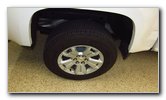 2019 Colorado Rear Wheel |
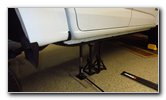 Loosen Lug Nuts - Raise |
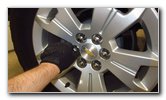 Spin Off Six Lug Nuts |
| This automotive
maintenance tutorial was specifically written to assist owners of the second
generation (2015, 2016, 2017, 2018, 2019, 2020, 2021 and 2022 model years) GM Chevrolet Colorado truck in changing the rear disc brake pads
and lubricating the caliper slider pins. Owners of other General Motors vehicles from Chevrolet, GMC, Cadillac, Buick and Holden such as the Trax, Equinox, Traverse, Blazer, Tahoe, Suburban, Sonic, Cruze, Trailblazer, Spark, Malibu, Impala, Volt, Bolt, Corvette, Camaro, Silverado, Express, Regal, LaCrosse, Cascada, Encore, Enclave, Envision, Canyon, Sierra, Terrain, Acadia, Yukon, XT4, XT5, XT6, Escalade, CT5, CTS, XTS, CT6, ATS, Astra and Commodore may also find these DIY instructions to be helpful. A few compatible replacement sets of new rear brake pads with their part numbers are as follows: Power Stop 17-1806, EBC Brakes DP43045R, ACDelco 17D1806CH, Raybestos EHT1806H and Bendix CFC1806. The tools needed to complete this procedure include a lug nut wrench, a floor jack, two jack stands, a 12mm socket with a 3/8" drive ratchet, an "F" clamp and a tube of brake caliper grease. The first few steps are to drive the truck on a to a level surface, shift the transmission into "Park" and turn off the ignition. Place wheel chocks on both sides of the front tires to prevent the vehicle from moving. Make sure that the emergency / parking brake is NOT engaged. If the parking brake is engaged, you will not be able to pull the caliper out of the bracket and off the old pads. The lug nut wrench is located under the rear passenger seats and the bottle jack is located behind the backrest of the rear seats. Slightly loosen the six lug nuts on the rear wheel about 1/4 to 1/2 turn in the counterclockwise direction with the tire iron. Carefully raise the rear of the truck with the bottle floor jack and securely support it with at least two jack stands. Please do not solely rely on the floor jack to support the vehicle! I prefer to just work on one side of the truck at a time to keep three tires on the ground for extra safety. Spin off the six lug nuts and set them aside in a safe place. |
||
|
|
||
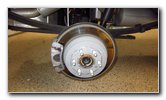 Bracket, Caliper, Rotor |
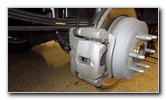 Rear Brake Caliper |
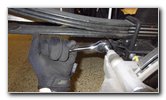 Loosen Upper Bolt |
| Carefully remove
the rear wheel and set it aside in a safe place. Some home mechanics prefer to place the wheel and tire under the frame rail as a backup support device just in case the vehicle falls off the jack stands. Once the wheel is out of the way, you'll be able to see the caliper, bracket, rotor and suspension. The rear brake caliper is held in place to the bracket by two bolts situated on the back side of the caliper. The bolt heads face in towards the cargo bed in the center of the truck. Loosen the top caliper bolt by turning it in the clockwise direction (as seen from the outside of the vehicle) with the 12mm socket and a 3/8" drive ratchet. |
||
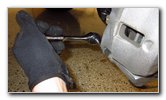 Loosen Lower Bolt |
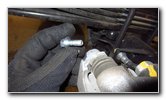 Spin Out Caliper Bolts |
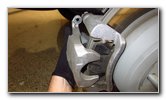 Lift Caliper Out of Bracket |
| Then loosen the
bottom caliper bolt by turning it in the clockwise direction (when viewed
from the outside of the truck) with the 12mm socket and a 3/8" drive
ratchet. Spin out the two caliper bolts and set them aside in a safe place. Carefully lift the caliper off the old pads and out of the bracket. Try to avoid pulling, stressing, kinking or bending the rubber brake fluid hose. |
||
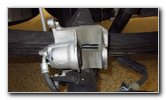 Rest Caliper On Suspension |
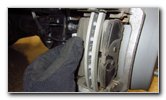 Remove Old Inner Pad |
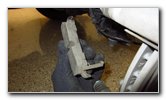 Wear Bar - Bottom |
| Rest the caliper on
the suspension or suspend it from the spring with a bungee cord. Pull the old inner and outer brake pads out of the bracket. Make a mental note of where the wear indicator bar or "squeal" bar is situated on the old pads. On this 2019 Colorado LT, the wear indicator bar was situated at the bottom of the inner brake pad. |
||
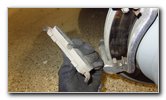 Remove Old Outer Pad |
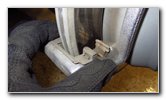 Two Pad Abutment Clips |
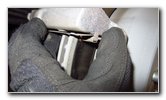 Change Abutment Clips |
| If your set of new
rear pads includes a bag of replacement brake hardware, pull the old pad
abutment or "anti-rattle" clips out of the top and bottom of the bracket. Clean off the lug studs, caliper, bracket and rotor with brake parts cleaner spray. Try to avoid breathing in the brake dust or cleaner spray as they might be carcinogenic (cancer causing). Apply a thin layer of brake parts lubricant grease to the surfaces of the new pad abutment clips where they will come in contact with the bracket or the new pads. Push the new pad abutment clips into the top and bottom of the bracket. Make sure the clips are fully seated. Avoid getting caliper grease on to the friction surface of the rotor or the new pads. |
||
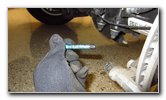 Caliper Slider Pins |
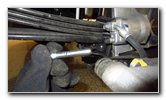 Lubricate & Replace Pins |
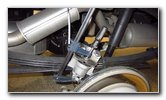 Attach "F" Clamp |
| In order for the
caliper to operate smoothly, the two caliper slider pins or "guide bolts"
need to be well lubricated. Pull the two caliper slider pins out of their rubber dust boots attached to the bracket. Apply a thin layer of brake caliper grease to the smooth parts of each pin. Push the pins back into their rubber dust boots. Spin them around and push them in and out a few times to help spread the grease. Attach the "F" clamp to the caliper and use an old brake pad to evenly spread the pressure across the piston. Move to the right rear area of the engine bay and locate the brake fluid reservoir tank. |
||
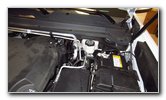 Brake Fluid Reservoir |
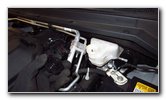 Twist Off Counterclockwise |
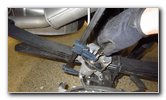 Compress Caliper Piston |
| Twist off the brake
fluid reservoir cap in the counterclockwise direction and set it aside in a
safe place. Slowly turn the "F" clamp handle in the clockwise direction until the caliper piston is just about flush with the rubber dust boot that surrounds it. Repeatedly check the fluid level in the reservoir while you compress the piston to make sure it doesn't overflow. As soon as you have completed compressing the caliper piston, replace the reservoir cap. Brake fluid is hygroscopic (absorbs moisture from the air), so the cap should not be left off for any longer than necessary. |
||
|
|
||
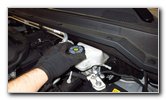 Replace Reservoir Cap |
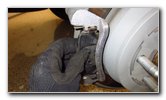 Install New Outer Pad |
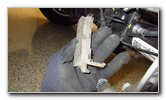 Wear Bar - Bottom Inner |
| To replace the
reservoir cap, twist it on in the clockwise direction. If your truck has been exhibiting shuddering or vibrations in the rear end during braking, you may need to replace the OEM rotors with new rotors. A few compatible replacement rear rotors with their part numbers include the following: ACDelco 177-1227 (OEM), Raybestos 582039PER and DuraGo BR901414. To replace the rear rotors, remove the Torx T-30 set screw on the outer face of the rotor, remove the two large bolts on the back side of the bracket, remove the bracket, slide off the old rotor and slide the new one into place. If the old rotor is stuck due to rust or debris, loosen it by hitting it with a rubber mallet. Install the two new brake pads into the bracket. The wear indicator bar should be situated at the bottom of the inner brake pad. |
||
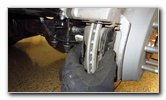 Push Pads Against Rotor |
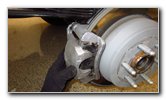 Lower Caliper Over Pads |
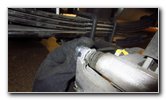 Spin In Top Caliper Bolt |
| Push the two pads
together until they are flush against the rotor. Carefully lower the caliper over the new pads and into the bracket. If you are unable to place the caliper over the thicker new pads, you may need to compress back the piston a bit further. Line up the bolt holes in the caliper with their corresponding holes in the slider pins within the bracket. Spin in the two caliper bolts a few turns by hand in the counterclockwise direction (as seen from the outside of the truck) to help prevent them from becoming cross threaded. |
||
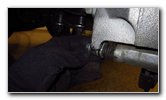 Spin In Bottom Bolt |
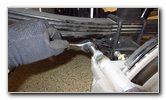 Tighten Upper Bolt |
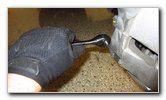 Tighten Lower Bolt |
| Tighten the two
caliper bolts in the counterclockwise direction (as seen from the outside of
the truck) with the 12mm socket and a 3/8" drive ratchet to just past hand
tight or about 25 lb-ft of torque. I recommend using Loctite Blue (medium strength - removable) thread locking adhesive on the caliper bolts to help prevent them from vibrating loose especially if you take your truck off-road. Double check that the two bolts are tight before moving on to the next steps. |
||
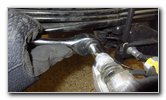 Caliper Bolts Secured |
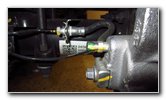 Rubber Valve Cap |
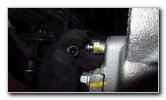 Brake Fluid Bleeder Valve |
| If your brake pedal
has been feeling soft or spongy, the brake fluid in the lines might contain
some air bubbles or moisture. It would be best to bleed the brake fluid at
this time and replace it with fresh fluid.
I recommend using the Allstar Performance Bleeder Bottle since it makes bleeding the brake lines an easy one person job. Check out my Acura MDX Brake Line Bleeding Guide for more information on this topic and how to use the bleeder bottle. The brake fluid bleeder valve is located on the back side of the caliper just below the top caliper bolt. You'll need a 10mm wrench to open and close the bleeder valves. |
||
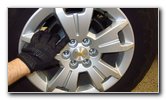 Replace Rear Wheel |
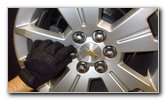 Spin On Six Lug Nuts |
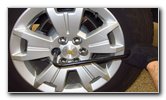 Slightly Tighten Clockwise |
| Push the rear wheel
back into place over the lug studs. Spin on the six lug nuts a few turns by hand in the clockwise direction to help prevent them from becoming cross threaded. Slightly tighten the lug nuts in the clockwise direction in a "star" or "criss-cross" pattern with the tire iron. |
||
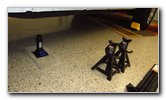 Lower Truck From Stands |
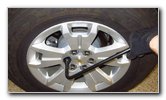 Torque Lug Nuts |
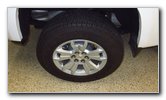 Rear Brake Pads Replaced |
| Carefully lower the
truck from the jack stands by using the floor jack. Continue tightening the lug nuts in a criss-cross or star pattern to about 1/8 to 1/4 turn past hand tight. It would be best to use a torque wrench to properly tighten the lug nuts to the owner's manual specification of 140 lb-ft of torque. Check the brake fluid level in the reservoir and if necessary, pour in some new DOT 3 brake fluid until it reaches the "MAX" (maximum or full) line. Sit in the driver's seat and firmly pump the brake pedal several times to restore the brake line pressure. Take the truck for a short test drive and listen closely for any strange sounds that might indicate a problem. It would also be a good idea to check your driveway, garage or parking spot for drops of fresh brake fluid and make sure that the lug nuts are still tight after your next few trips. Don't forget to write down the brake pad change in your truck's service records. Please check out all of my
2015-2019 GM Chevrolet Colorado DIY Repair & Maintenance Guides. |
||
| If you found this guide to be helpful,
please consider making a small donation by clicking on the PayPal.com
"Donate" button located to the right of this paragraph. Thank you!
(Note: I am not a registered charity. Donations are not tax deductible.) |

